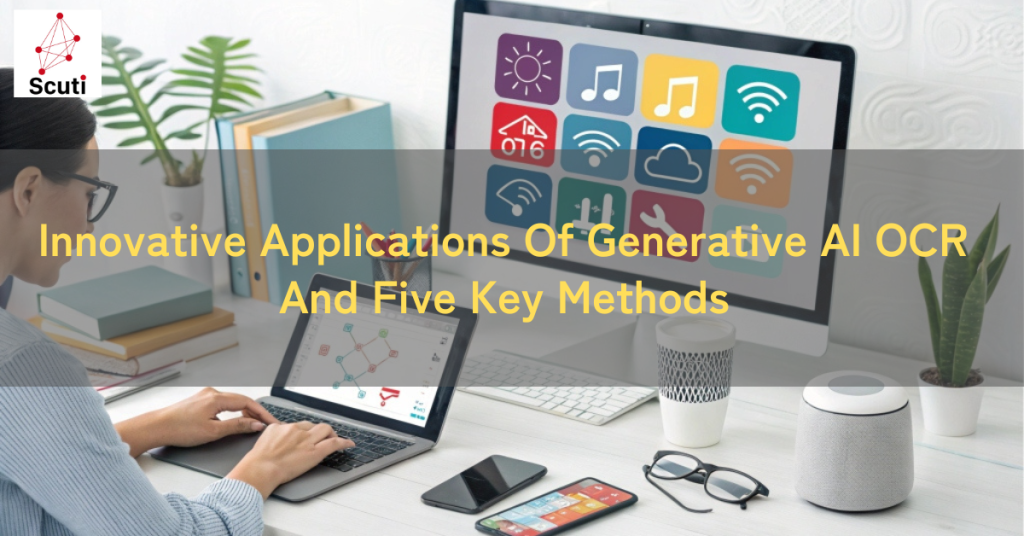
Hello, I am Kakeya, the representative of Scuti.
Our company specializes in services such as Offshore Development And Lab-type Development in Vietnam, as well as Generative AI Consulting. Recently, we have been fortunate to receive numerous requests for system development in collaboration with generative AI.
Are you struggling with the evolution of OCR technology? Traditional OCR systems often face challenges in accurately reading handwritten text and complex document layouts, creating obstacles to improving operational efficiency. Generative AI OCR not only overcomes these limitations but also introduces innovative possibilities for document processing.
In this article, we will explore five key applications of Generative AI OCR along with real-world examples to provide insights that can significantly enhance your business operations.
Traditional OCR Technology nd Its Limitations

If you want to learn more about AI OCR, be sure to check out this article first.
Related article: What is AI OCR? A Detailed Explanation of the Latest Technology and Industry Use Cases
Fundamentals and Applications of Traditional OCR Technology
Optical Character Recognition (OCR) has long been used across various industries as a technology for extracting text data from scanned paper documents and images. For example, financial institutions utilize OCR for invoice data entry, healthcare facilities use it for digitizing patient records, and law firms apply it to contract management.
However, traditional OCR technology comes with several critical limitations. One of the most significant challenges is its difficulty in accurately recognizing handwritten text and documents with complex layouts. This often hinders operational efficiency, prompting companies to seek new solutions. Additionally, traditional OCR heavily depends on image quality, making it difficult to extract accurate text from low-quality images.
Another limitation is its restricted language support, which makes it inadequate for global businesses requiring multilingual capabilities. Furthermore, traditional OCR has limited contextual understanding, making it difficult to process complex documents.
Moreover, adapting to new document types requires significant time and costs, leading to a lack of flexibility. To overcome these challenges, Generative AI OCR has emerged as an advanced solution.
Key Limitations of Traditional OCR
Traditional OCR relies on template matching trained on specific fonts and layouts, leading to the following limitations:
- Difficulty handling handwritten text and complex document layouts
- Heavy dependence on image quality
- Limited language support
- Poor contextual understanding
- High time and cost requirements for adapting to new document types
To address these challenges, Generative AI OCR has been developed as a breakthrough solution.

Generative AI OCR: A Revolutionary Document Processing Technology

Overview and Technical Foundations of Generative AI OCR
Generative AI OCR leverages advanced AI technologies such as deep learning and natural language processing (NLP) to overcome the limitations of traditional OCR technology and enable more sophisticated document processing.
Specifically, it utilizes deep learning models pre-trained on vast amounts of text and image data, allowing it to extract text with high accuracy even from handwritten documents and complex layouts. Generative AI OCR continuously improves its accuracy through adaptive learning, correcting errors and enhancing reliability over time.
Additionally, it excels in pattern recognition, enabling it to accurately recognize, interpret, and decode intricate patterns and contextual information within images. This advancement makes the recognition of handwritten text and processing of complex document layouts significantly more efficient than before. By utilizing optimized algorithms and parallel processing capabilities, Generative AI OCR accelerates text recognition, interpretation, and decoding within documents. This results in a substantial increase in processing speed, thereby improving operational efficiency.
Furthermore, Generative AI OCR functions as an Intelligent Document Processing (IDP) solution by integrating OCR technology with advanced NLP and machine learning algorithms to automate document-centric tasks. This enables data extraction, classification, and contextual understanding, facilitating the automation of business processes.
Five Innovative Applications of Generative AI OCR

1. Improved Accuracy and Versatility
Generative AI OCR leverages deep learning models trained on vast datasets to extract text with high accuracy, even from handwritten text and complex document layouts that traditional OCR struggles to recognize.
- Adaptive Learning: The Generative AI OCR model continuously learns and refines its accuracy by correcting errors.
- Pattern Recognition: It accurately recognizes, interprets, and deciphers complex patterns and contextual information.
- Handwritten Text Processing: It excels in recognizing handwritten characters with high precision.
- Handling Complex Layouts and Graphics: It can extract text accurately even from documents with intricate structures.
2. Faster Processing Speed
Generative AI OCR enhances document text recognition, interpretation, and decoding by utilizing optimized algorithms and parallel processing capabilities. Compared to traditional OCR, it significantly boosts processing speed and improves operational efficiency. This is particularly beneficial for businesses that need to process large volumes of documents in a short time.
Generative AI OCR optimizes text recognition processes and executes multiple tasks simultaneously using parallel processing, enabling rapid data extraction and analysis, ultimately accelerating workflow efficiency.
Furthermore, the increased processing speed allows for real-time data processing, facilitating immediate decision-making. This helps businesses remain competitive in fast-paced environments.
- Optimized Algorithms: Cutting-edge algorithms enhance processing speed significantly.
- Parallel Processing: Tasks are distributed across multiple processing units for faster data extraction and analysis.
3. Intelligent Document Processing (IDP) Solutions
Intelligent Document Processing (IDP) solutions integrate OCR technology with advanced NLP and machine learning algorithms to automate document-centric tasks. This enables companies to improve document processing efficiency and optimize business processes.
Generative AI OCR can automatically extract relevant information from invoices, contracts, and other documents, categorizing them based on predefined criteria. This reduces the burden of manual data entry and enhances operational efficiency. Additionally, Generative AI OCR leverages NLP capabilities to understand the context of extracted data, enabling more advanced analysis. As a result, businesses can maximize the value of their data and support decision-making.
The IDP solution powered by Generative AI OCR serves as a crucial tool for promoting business process automation and enhancing corporate competitiveness.
- Data Extraction and Classification: Automatically extracts and categorizes relevant information from invoices and contracts.
- Contextual Understanding: NLP functionality enables comprehension of extracted data.

4. Seamless Integration with Existing Systems
Generative AI OCR solutions are designed to integrate seamlessly with an organization’s existing software and workflows. This minimizes disruptions during technology adoption and maximizes efficiency. Generative AI OCR eliminates the limitations of traditional OCR and is compatible with various file formats, document management systems, ERP software, and business applications. This allows businesses to leverage their existing systems while incorporating new technology.
Additionally, Generative AI OCR provides powerful APIs and SDKs, making it easy to integrate with custom applications and workflows. This enables businesses to incorporate OCR solutions into any application without extensive development work. The seamless integration of Generative AI OCR plays a crucial role in enhancing business processes and improving competitiveness.
- Compatibility: Supports a wide range of file formats, document management systems, ERP software, and more.
- API Support: Provides powerful APIs and SDKs for easy integration with custom applications.
5. Continuous Improvement Through Machine Learning
Generative AI OCR models continuously learn and adapt based on feedback and new data. This ongoing learning process enhances performance and adaptability, ensuring consistent improvements. Through iterative learning, models and algorithms are optimized, minimizing errors and improving accuracy.
Moreover, Generative AI OCR dynamically adapts to evolving document trends and patterns, allowing it to efficiently handle new challenges while maintaining peak performance over time. The continuous improvement of Generative AI OCR helps businesses quickly adapt to changing environments and maintain a competitive edge.
- Iterative Learning Process: Improves models and algorithms through continuous feedback loops.
- Dynamic Adaptation: Responds to new document trends and patterns to maintain top-level performance.
Real-World Applications of Generative AI OCR

1. Automating Document Processing in the Financial Industry
Financial institutions handle vast amounts of documents from customers. By leveraging Generative AI OCR, they can automatically extract essential information from account opening documents, loan applications, and insurance claims, significantly reducing the burden of manual data entry. Additionally, it assists in fraud detection, enhancing efficiency and improving the quality of customer service.
Furthermore, Generative AI OCR contributes to compliance enforcement in the financial sector. For example, when regulatory requirements demand accurate document processing and storage, Generative AI OCR automates these processes, reducing human errors. This ensures legal compliance and minimizes risks for financial institutions. By adopting Generative AI OCR, the financial industry can accelerate digital transformation and maintain its competitive edge.
2. Enhancing Electronic Medical Records in the Healthcare Industry
In healthcare, digitizing patient records improves information sharing and helps prevent medical errors. Generative AI OCR accurately converts handwritten medical records and image-based data into text-based electronic health records (EHRs), facilitating smooth integration into electronic medical record systems. This enables healthcare professionals to quickly access patient information, enhancing the quality of medical care.
Additionally, Generative AI OCR aids in medical data analysis. For instance, it can automatically extract patient history and test results, allowing for statistical analysis that contributes to improving healthcare quality and developing new treatment methods. As a result, medical institutions can provide more efficient and effective healthcare services. The adoption of Generative AI OCR supports digital transformation in the healthcare industry, ultimately improving patient care.
3. Speeding Up Contract Review In the Legal Industry
Law firms spend a significant amount of time and effort reviewing contracts and legal documents. Generative AI OCR can automatically extract key clauses and dates, streamlining the review process for lawyers. This enhances workflow efficiency and enables law firms to provide faster legal services to their clients.
Additionally, Generative AI OCR serves as a tool to ensure accuracy in legal documents. For instance, it can automate the verification process of contract clauses, reducing the likelihood of human errors. This allows law firms to build trust with clients and mitigate legal risks. The implementation of Generative AI OCR optimizes legal workflows and enhances competitiveness within the legal industry.

4. Enhancing Quality Control in the Manufacturing Industry
In manufacturing, companies must manage inspection records and reports to ensure product quality. Generative AI OCR helps automatically extract relevant information from these documents and integrate it into quality management systems, improving both efficiency and accuracy. This enables manufacturers to maintain product quality and enhance customer satisfaction.
Furthermore, Generative AI OCR contributes to optimizing manufacturing processes. For example, it can analyze defect rates automatically and identify areas for improvement, leading to greater production efficiency. This allows manufacturers to reduce costs while maintaining a competitive edge. By adopting Generative AI OCR, the manufacturing industry can strengthen quality control and achieve sustainable growth.
5. Learning Support in the Education Industry
Educational institutions spend significant time and effort evaluating student assignments and reports. Generative AI OCR converts handwritten answers and reports into text data, integrating it with automated grading systems, reducing the burden on teachers. This enables institutions to enhance educational quality and maximize student learning outcomes.
Additionally, Generative AI OCR aids in education data analysis. For example, it can analyze student learning patterns and provide personalized learning support, ultimately improving the quality of education. This allows educational institutions to enhance student performance and optimize learning processes. By implementing Generative AI OCR, the education sector can improve efficiency in educational processes and achieve sustainable education development.
The Future Of Generative AI OCR

Future Development Areas of Generative AI OCR
Generative AI OCR is still an evolving technology, but its potential is limitless. In the future, further advancements are expected in the following areas:
- Enhanced Multilingual Support: Expanding language compatibility will facilitate global business operations, allowing companies to increase their competitiveness in international markets.
- Development of Video OCR: Extracting text information from videos will streamline meeting and lecture documentation, improving information sharing and utilization for businesses and educational institutions.
- Improved Document Summarization: Automatically extracting key points from lengthy documents will enable faster information comprehension and decision-making.
- Enhanced Data Structure Preservation: Extracting text while maintaining the original document structure will enable more advanced data analysis, maximizing the value of extracted information.
Generative AI OCR has the potential to revolutionize business processes across various industries by automating and optimizing document processing. As technology continues to advance, companies that adopt this innovation can maintain competitiveness and achieve sustainable growth.
Conclusion
Generative AI OCR is an innovative technology that overcomes the limitations of traditional OCR and opens new possibilities in document processing. Its high accuracy and versatility in handling handwritten text and complex layouts, faster processing speed, seamless integration with existing systems, and continuous improvements through machine learning make it a powerful tool.
Industries such as finance, healthcare, law, manufacturing, and education are already leveraging this technology, and further developments are expected. By adopting Generative AI OCR, businesses can enhance operational efficiency, reduce costs, and improve customer satisfaction. Most importantly, Generative AI OCR drives automation in business processes, strengthening companies’ competitive advantages.
Furthermore, Generative AI OCR accelerates digital transformation, helping organizations achieve sustainable growth. As the technology continues to evolve, businesses that embrace it will be well-positioned to maintain their competitiveness and thrive in an increasingly digital world.
